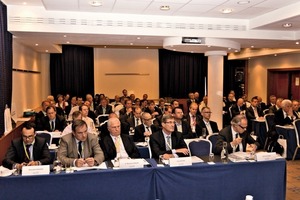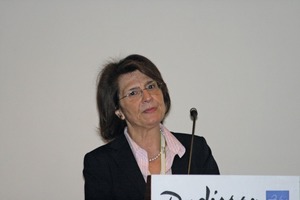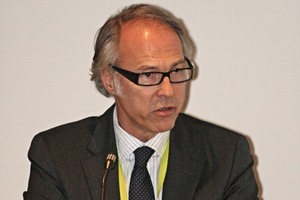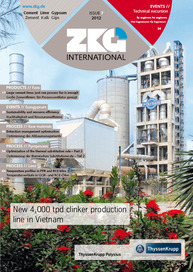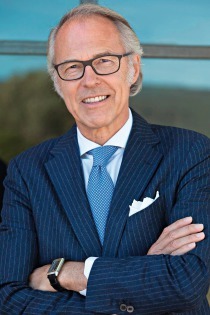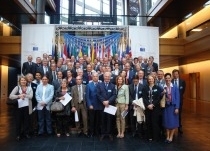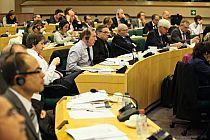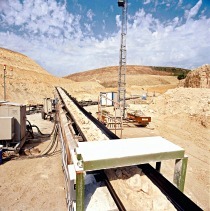Gypsum is at the core of a sustainable and resource-efficient built environment
Bernard Lekien, President of Eurogypsum for the last two years, opened the conference day with the title, “Gypsum is at the core of a sustainable and resource-efficient built environment.” It was attended by around 85 delegates from Europe, and also some delegates from the US. Co-hosted by Eurogypsum and Polski Gips (the Polish Gypsum Association), it was the first time that the conference took place in central Europe.
After a welcome address from the Polish Minister of Transportation and Construction, held by his Undersecretary of State Janusz Z˙bik, the Congress delegates heard a variety of presentations from experts in gypsum extraction, academics and designers active in the construction field. The conference day was divided into two sections: “Sustainable extraction – minerals for a sustainable built environment” and “Sustainable construction – a resource efficient approach”.
The keynote speech was held by the deputy head of the unit “Metals and raw materials” at the European Commission, Maria Spiliopoulou Kaparia about stimulating sustainable construction and extraction in the EU. She explained that the supply of raw materials to the European economy is coming under increasing pressure due to several factors such as the growth of the global population and the ageing society. The EC therefore has decided to become more sustainable and efficient. Europe’s Raw Material Strategy, as presented in „Commodities Markets and Raw Materials communication“, reflects this and addresses the entire value chain. It is based on the three pillars of the 2009 Raw Materials Initiative: fair and sustainable supply of raw materials from international markets, fostering sustainable supply within the EU, and boosting resource efficiency and promoting recycling.
Dominique Bailly, Mayor of the municipality of Vaujours/France, a small town near Paris, showed the audience his point of view for gypsum as an essential raw material for durable growth and the benefits for local communities by improved extraction techniques. Vaujours has a long history related to gypsum, which has been exploited for centuries in local quarries.
The Ecologist Prof. Grégory Mahy from the University of Gembloux/Belgium explained to the participants the results of a case study he recently did in biodiversity. The focus lay on the usual conflict between mining companies and conservationists, but also showed results, that quarrying adds values to the ecosystem and society. “The future of ecosystems and society is perhaps in their coexistence in quarries”, Mahy said. Eco buildings might be a way to add value to quarries by reintegrating human beings in nature.
Dr. Hans Joachim Feuerborn, Secretary General of ECOBA, the European Coal Combustion Products Association, Essen/Germany, reported about the use of FGD gypsum, which has been produced in the wet flue gas desulphurisation process of sulphur oxide emitting processes, especially of those in coal-fired power plants. Coal combustion has an effect on the environment which must be kept as low as possible. Clean coal technology in coal-fired power plants today is not only addressed to de-NOx and de-SOx systems but also to carbon-free production based on carbon capture storage. In addition, the gypsum produced should not be seen as a by-product only, but as a regular raw material, said Dr. Feuerborn.
After the lunch break, the second part of the congress started with Georg Rötzel from Dr. Schmidhuber & Kaindl, Munich/Germany, consulting engineers and architects. He explained why gypsum is the right answer to the creation of habitat with a positive environmental footprint. Thus, modern design can meet traditional European solid stone building, modernized to today’s standards. Quality design and sustainable flexible construction methods define the perspectives of tomorrow’s building generation.
Dr. Wolfgang Zillig from the Fraunhofer Institute for Building Physics (IBP), Stuttgart/Germany, lectured about “Interior Insulation Systems: techniques, challenges and merits” and showed new methods and solutions in keeping moisture out of buildings that are insulated on the inside after renovation.
Finally Mike Falconer Hall, Programme Area Manager at the Waste & Resources Action Programme (WRAP), Banbury/UK, showed, how multistakeholders approach to sustainability by creating the Plasterboard Sustainability Partnership (PSP) in the UK. As plasterboard is a widely used construction product, it is crucial to build upon these successes and further improve the sustainability of this product throughout its life cycle and supply chain.
The moderator of the conference was Borys Czarakcziew, the President of the Polish Regional Architects Chamber of Commerce.
The 29th Eurogypsum Congress ended with a subterranean gala dinner in the famous Wieliczka salt mine, one of the oldest salt mines of the world with a shaft dating from the year 1280.

